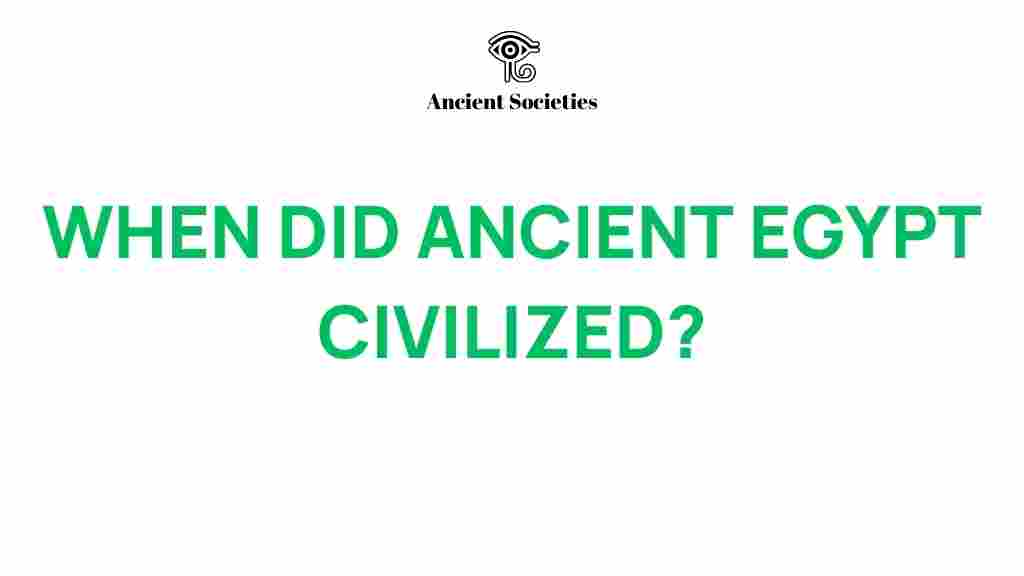Unraveling the Mysteries: When Did Ancient Egypt Truly Civilize?
Ancient Egypt is one of the most captivating civilizations in history, renowned for its remarkable achievements in architecture, art, and governance. The civilization along the banks of the Nile River has fascinated historians, archaeologists, and enthusiasts for centuries. But when did this ancient society truly begin its journey towards civilization? In this article, we will explore the key milestones in the development of Ancient Egypt, its culture, and the factors that contributed to its rise as a prominent civilization.
The Birth of Civilization in Ancient Egypt
The genesis of Ancient Egypt’s civilization can be traced back to around 3100 BC, marked by the unification of Upper and Lower Egypt. This unification is attributed to the first pharaoh, Narmer (also known as Menes), who established a centralized state. The following points highlight significant developments during this period:
- Formation of the Kingdom: The unification led to the establishment of a monarchy, which was essential for governance and social order.
- Development of Agriculture: The Nile River provided fertile land, which was crucial for agriculture, allowing the society to sustain itself.
- Hieroglyphs and Writing: The creation of hieroglyphs during this time marked a significant advancement in communication and record-keeping.
The Role of the Nile in Shaping Civilization
The Nile River was the lifeblood of Ancient Egypt, playing a crucial role in its development. Here are some ways the Nile influenced the civilization:
- Fertile Land: The annual flooding of the Nile deposited nutrient-rich silt, making the land highly fertile and suitable for agriculture.
- Transportation and Trade: The Nile served as a vital transportation route, facilitating trade and communication among ancient societies.
- Religious Significance: The river was revered in Ancient Egyptian culture, symbolizing life and fertility, and was often associated with various deities.
Pharaohs: The Divine Rulers of Ancient Egypt
The pharaohs were central figures in Ancient Egyptian civilization, regarded as both political leaders and divine entities. Their role can be summarized as follows:
- Political Authority: Pharaohs wielded absolute power, controlling land, resources, and the military.
- Religious Leadership: They were considered intermediaries between the gods and the people, responsible for maintaining ma’at (cosmic order).
- Patrons of Culture: Pharaohs commissioned monumental architecture, such as pyramids and temples, which reflected the society’s grandeur.
Archaeology: Uncovering the Past
Archaeological discoveries have played a pivotal role in unraveling the mysteries of Ancient Egypt. Key findings include:
- Pyramids: The Great Pyramid of Giza is one of the Seven Wonders of the Ancient World, showcasing the engineering prowess of Ancient Egyptians.
- Tombs: The discovery of tombs, such as those in the Valley of the Kings, has provided invaluable insights into burial practices and beliefs about the afterlife.
- Artifacts: Everyday objects, pottery, and tools discovered in various archaeological sites reveal much about the daily lives and culture of ancient societies.
Hieroglyphs: The Language of the Gods
Hieroglyphs are a fascinating aspect of Ancient Egyptian civilization, serving as a form of writing that combined logographic and alphabetic elements. Their significance includes:
- Record Keeping: Hieroglyphs were used for religious texts, state documents, and inscriptions on monuments.
- Cultural Expression: The intricate designs and symbols conveyed not only language but also artistic expression, reflecting the society’s beliefs and values.
- Decipherment: The Rosetta Stone, discovered in 1799, was crucial for understanding hieroglyphs and unlocking the history of Ancient Egypt.
Cultural Aspects of Ancient Egyptian Civilization
The culture of Ancient Egypt was rich and varied, encompassing religion, art, and social structure. Some key cultural aspects include:
- Religion: Polytheism was central to Ancient Egyptian life, with gods representing various aspects of nature and society.
- Art and Architecture: Art was heavily influenced by religious themes, with sculptures and paintings adorning tombs and temples.
- Social Hierarchy: Society was hierarchical, with pharaohs at the top, followed by priests, nobles, and laborers.
Challenges in Understanding Ancient Egyptian Civilization
Despite extensive research, several challenges persist in fully understanding Ancient Egyptian civilization:
- Limited Written Records: Many texts have deteriorated over time, leaving gaps in historical knowledge.
- Interpretation of Artifacts: The meaning of certain artifacts and symbols can be subjective and open to interpretation.
- Preservation Issues: Environmental factors and human activities have led to the degradation of archaeological sites.
Conclusion: The Enduring Legacy of Ancient Egypt
Ancient Egypt’s journey towards civilization is marked by significant milestones that shaped its unique identity. From the unification of the kingdoms to the establishment of a complex society governed by powerful pharaohs, the civilization along the Nile has left an indelible mark on history. The achievements in art, architecture, and governance continue to inspire and fascinate people worldwide.
As we delve deeper into the mysteries of Ancient Egypt, we uncover not only the story of a remarkable civilization but also the enduring legacy that continues to influence modern culture. For those interested in exploring more about ancient societies, you can visit this resource for further insights.
To stay updated on the latest discoveries and insights in Ancient Egyptian archaeology, check out Archaeology Magazine.
This article is in the category History and created by AncientSocieties Team
